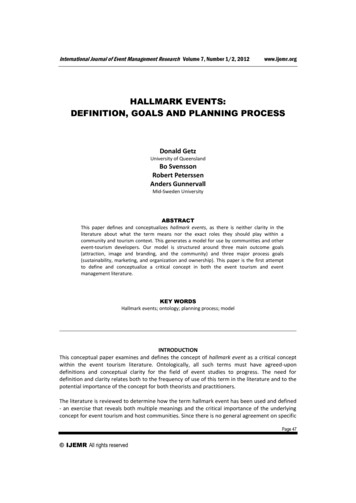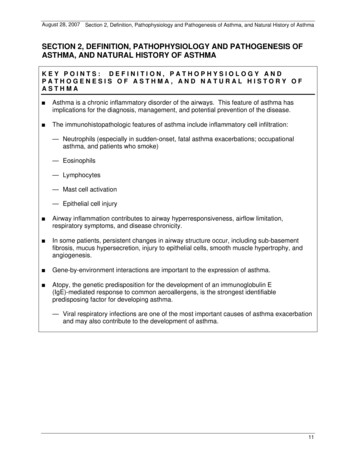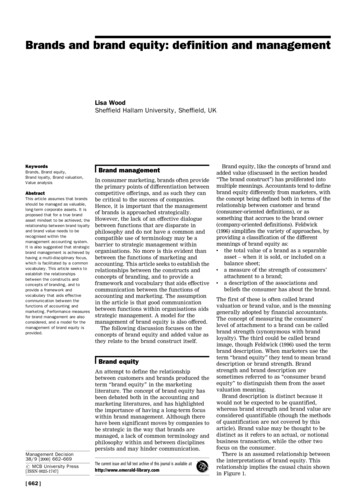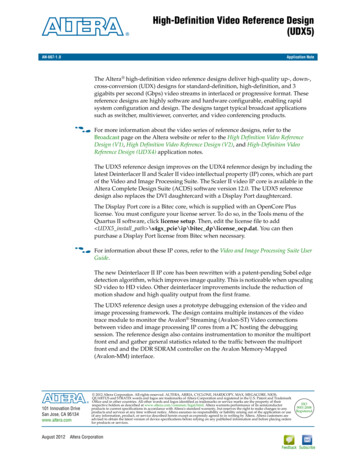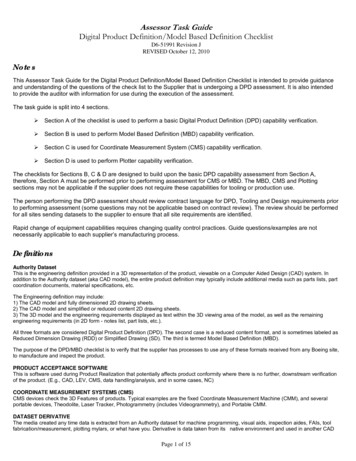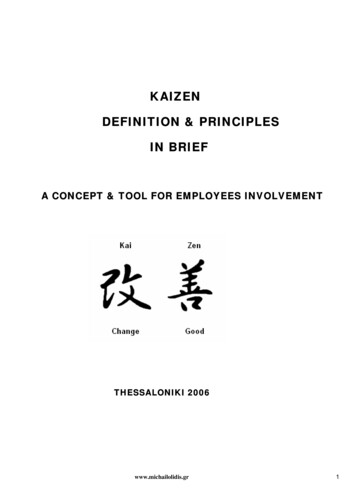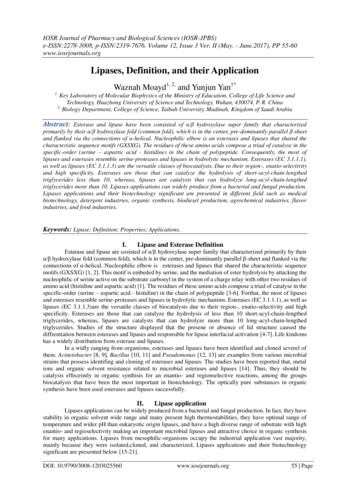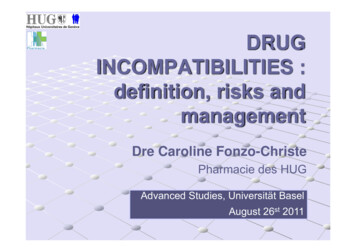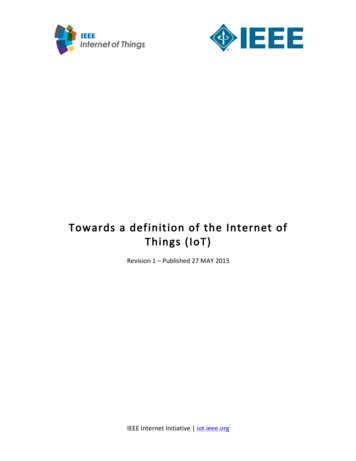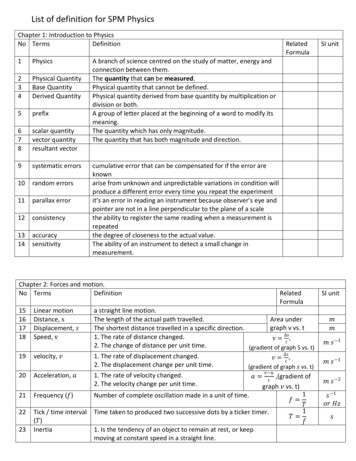
Transcription
List of definition for SPM PhysicsChapter 1: Introduction to PhysicsNo TermsDefinition1Physics234Physical QuantityBase QuantityDerived Quantity5prefix678scalar quantityvector quantityresultant vector9systematic errors10random errors11parallax rmulaA branch of science centred on the study of matter, energy andconnection between them.The quantity that can be measured.Physical quantity that cannot be defined.Physical quantity derived from base quantity by multiplication ordivision or both.A group of letter placed at the beginning of a word to modify itsmeaning.The quantity which has only magnitude.The quantity that has both magnitude and direction.Two vector acting at a point can be replaced by a single vectorwith the same effect.cumulative error that can be compensated for if the error areknownarise from unknown and unpredictable variations in condition willproduce a different error every time you repeat the experimentit’s an error in reading an instrument because observer’s eye andpointer are not in a line perpendicular to the plane of a scalethe ability to register the same reading when a measurement isrepeatedthe degree of closeness to the actual value.The ability of an instrument to detect a small change inmeasurement.Chapter 2: Forces and motion.No TermsDefinition15161718Linear motionDistance, sDisplacement, 𝑠Speed, v19velocity, 𝑣20Acceleration, 𝑎21Frequency (𝑓)22Tick / time interval(𝑇)Inertia23SI unitRelatedFormulaa straight line motion.The length of the actual path travelled.Area undergraph v vs. tThe shortest distance travelled in a specific direction. s1. The rate of distance changed.v 𝑡,2. The change of distance per unit time.(gradient of graph S vs. t) 𝑠1. The rate of displacement changed.𝑣 𝑡,2. The displacement change per unit time.(gradient of graph 𝑠 vs. t)1. The rate of velocity changed.2. The velocity change per unit time.𝑎 SI unit𝑚𝑚𝑚 𝑠 1𝑚 𝑠 1𝑣 𝑢,(gradient ofgraph 𝑣 vs. t)1Number of complete oscillation made in a unit of time.𝑓 𝑇1Time taken to produced two successive dots by a ticker timer.𝑇 𝑓1. Is the tendency of an object to remain at rest, or keepmoving at constant speed in a straight line.𝑡𝑚 𝑠 2𝑠 1𝑜𝑟 𝐻𝑧𝑠
322. Is the property of a mass which resists change from its stateof rest or motion.Newton’s First Law State that an object will remain at rest or continue with aof motionconstant speed in a straight line (i.e. constant velocity) unlessacted on by an unbalanced force.𝑚𝑣 𝑚𝑢𝑁Newton’s SecondState that the force acts on an object is directly proportional to𝐹 𝑡Law of motionthe rate of change of momentum.Newton’s ThirdState that an action force will produce a reaction force, withLaw of Motionsame magnitude by act in opposite direction.𝑝 𝑚 𝑣𝑘𝑔 𝑚 𝑠 1MomentumThe product of mass and velocity.𝑚𝑣 𝑚𝑢 𝐹𝑡 𝑘𝑔 𝑚 𝑠 1ImpulseChange in momentum.Principle ofState that if there is no external force acting on the objects,𝑚1 𝑢1 𝑚2 𝑢2conservation ofthe total momentum before collision is equal to the total 𝑚1 𝑣1 𝑚2 𝑣2momentummomentum after the collision.Elastic collisionCollision of particles which its total kinetic energy is conserved.(particles does not stick together after collide)Inelastic collisionCollision of particles which its total kinetic energy is notconserved. (particle stick together after collide)𝑚𝑣 𝑚𝑢Impulsive forceForce which only act within a very short duration.𝐹 ; 𝑡 𝑖𝑠 𝑠𝑚𝑎𝑙𝑙33Balanced forces343536Unbalanced forcesResultant forceGravitational field3739404142Gravitationalacceleration, 𝑔Gravitational fieldstrength, 𝑔Free fallWeightMassWork4344EnergyKinetic energyFall due to the gravitational pull only.The product of mass and gravitational field strength.The amount of particles consist in an objectThe product of force and displacement of an object in thedirection of the applied force.An ability to do work.Is the energy possessed by a body by virtue of its motion.45Power, 𝑃The rate of doing work or using energy.46Conservation ofenergyEfficiency, 𝜀The total amount of energy is unchanged during thetransformation of energy from one form to another.Is the percentage of useful energy transformedcompared to total energy input.Is the energy store by an object due to its alPotential EnergyElastic PotentialEnergyElasticityDo not affect an object’s motion. The object will remainstationary, or continue to move at a constant velocity in astraight line.Object will accelerates or decelerates in a straight line.The sum of forces which act on an object.Region in which an object experiences gravitationalattraction/pull towards the centre of the earth.Accelerate due to the pull of the gravitational force.gravitational force which acted on a unit of mass𝑔 10 𝑚 𝑠 2𝑔 𝜀 𝑊𝑚𝑔 10 𝑁 𝑘𝑔 1𝑊 𝑚 𝑔𝑊 𝐹 𝑠𝑁𝑘𝑔𝐽 𝑜𝑟 𝑁𝑚𝐽 𝑜𝑟 𝑁𝑚1𝐽𝑚𝑣 22𝐸𝑊 𝑊𝑎𝑡𝑡𝑃 𝐽𝑠 1𝑡𝐸. 𝐾. 𝑢𝑠𝑒𝑓𝑢𝑙 𝑒𝑛𝑒𝑟𝑔𝑦 𝑡𝑟𝑎𝑛𝑠𝑓𝑜𝑟𝑚𝑒𝑑 100%𝑇𝑜𝑡𝑎𝑙 𝑒𝑛𝑒𝑟𝑔𝑦 𝑖𝑛𝑝𝑢𝑡𝐺. 𝑃. 𝑚𝑔 111. Energy that store in a spring which is compressed or𝐸. 𝑃. 𝑘𝑥 2 𝑜𝑟 𝐹𝑥22stretched.(Area under graph F vs. x)2. The work done to compress / stretch the spring.The characteristic of an object which can return to its original shape𝐽𝐽
5152Extension, 𝑥Elastic limit53Hooke’s Law54Elastic constant, 𝑘after the applied force is removed.Difference in length of an elastic object compared to its original length.𝑥 𝑙 𝑙𝑜Is a limit when it is not exceeded, the spring cannot be able toreturn to its original length.States that the force, F, applied to a spring is directly𝐹 𝑘𝑥, 𝑜𝑟𝐹 𝑘(𝑙 𝑙𝑜 )proportional to the spring’s extension or compression, x.𝐹is the force required to produce a unit of extension or𝑘 𝑥 , gradient𝑁 𝑚 1compression.of graph F vs. xChapter 3: Forces and PressureNo TermsDefinition55Pressure, 𝑃The force acting normally on a unit of surface area.56Density, 𝜌The mass consists in a unit volume.57Pascal’s Principle58596061State that in a fluid, an externally applied pressure istransmitted uniformly in all directions.Archimedes’State that an object, whether completely or partiallyprincipleimmersed in a fluid, is acted on by a buoyant force, which isequal to the weight of the displaced fluid.Bernoulli’s Principle State that in a steady flow of a fluid, the pressure of the fluiddecreases when the velocity of the fluid increases.Apparent weightThe weight of an object in a fluid.Real weightThe weight of an object in the air.Chapter 4: HeatNo TermsDefinition62The net rate of heat transfer between two bodies is zero.63ThermalequilibriumThermal contact64Heat capacity65specific heatcapacitylatent heat6667686970latent heat offusionlatent heat ofvaporisationspecific latent heatspecific latent heatof fusionTwo objects are in thermal contact if heat can flowbetween them.The amount of heat energy needed to increase thetemperature of an object by 1 degree Celsius.The quantity of heat energy required to increase thetemperature by 1 kg of substance by 1 degree Celsius or 1 k.The total energy absorbed or released when a substancecompletely changed its physical state at a constanttemperature.The heat absorbed when a solid melts at constanttemperature.The heat absorbed when a liquid change into vapour at aconstant temperatureAmount of heat required to change the phase of 1 kg of asubstance at a constant temperatureAmount of heat energy required to change 1 kg f asubstance from a solid phase to a liquid phase without achange in temperatureRelatedFormula𝐹𝑃 𝐴𝑚𝜌 𝑣𝐹1 𝐹2 𝐴1 𝐴2𝐵 𝑉𝜌𝑔RelatedFormula𝑄𝜃𝑄𝑐 𝑚𝜃𝐶 𝑄𝑚𝑄𝐿 𝑚𝐿 SI unit𝑃𝑎 𝑜𝑟𝑁 𝑚 2𝑘𝑔 𝑚 3𝑃𝑎𝑁SI unit𝐽 𝑜 𝐶 1𝐽 𝑘𝑔 1 𝑜 𝐶 1𝐽 𝑘𝑔 1𝐽 𝑘𝑔 1
71specific latent heatof vaporisation72Boyle’s law73Charles’ law74pressure law75Absolute zeroChapter 5: LightNo Terms767778798081828384858687Amount of heat energy required to change 1 kg of asubstance from liquid phase to the gaseous phase withouta change in temperature at its boiling point.The relationship between the pressure and volume of agiven mass of gas at a constant temperatureThe relationship between temperature and volume of agiven mass of gas at a constant pressure.The relationship between the pressure and temperature ofa given mass of gas at a constant volume.The lowest temperature can be achieved.𝐿 𝑄𝑚𝐽 𝑘𝑔 1𝑃1 𝑉1 𝑃2 𝑉2𝑉1 𝑉2 𝑇1 𝑇2𝑃1 𝑃2 𝑇1 𝑇20 K -273 𝑜 𝐶DefinitionRelatedFormulaSi Unit-angle of incidence, 𝑖 , is equal to the angle of reflection, r,( 𝑖 𝑟)-the incidence ray, normal, and reflected ray will all lie on thesame plane.Refractionis a bending of the path of light due to a change in speed as itenter a medium of different optical densityAngle of incidence, i The angle between normal and incident ray.Angle of reflection, r The angle between normal and reflected ray.sin 𝑖 𝐷 𝐶1Refractive index, 𝑛 ratio of sin 𝑖 to sin 𝑟𝑛 sin 𝑟 𝑑 𝑣 sin 𝑐Angle of refraction, r The angle between normal and refracted ray.Snell’s lawRatio of sin 𝑖 to sin 𝑟 is a constant which the constant is calledrefractive index.CriticalIs the angle of incidence which produces an angle ofangle, 𝑐refraction of 90 degree as light transmitted into a medium inwhich it travels at higher speed.total internalWhen light travel from higher dens medium to a lower densreflectionmedium, if the angle of incidence 𝑖 is greater than the criticalangle, 𝑐, and the light is no longer refracted but is internallyreflected.concave lensIs a lens which the middle is thinner than the edge.convex lensIs a lens which the middle is thicker than the edge.𝑣magnification ofThe magnification of an image is given by the ratio of an𝑀 image, 𝑀image distance, 𝑣 to object distance,𝑢.𝑢Law of reflectionChapter 6: WaveNo Terms88Transverse wave89Longitudinal wave90wavelength, 𝜆Definitiona wave in which the vibration of particle in the medium atright angle to the direction of a propagation of the wavethe wave in which the vibration of particle in the medium isparallel to the direction of a propagation of the wavethe distance between two successive point of the same phasein a waveRelatedFormulaSI unit
919293Amplitude, 𝐴Period, 𝑇frequency, 𝑓9495wave speed, 𝑣wave front9697DampingInternal damping9899External dampingResonance100 Incident wave101 Reflected wave102 Reflection103 Diffraction104 Principle ofsuperposition105 Interference ofwave106 Sound wave107 Loudness108 Pitch109 Electromagneticwave110 Audio frequency111 ElectromagneticspectrumNothe maximum displacement from its equilibrium positionthe time taken to complete an oscillationthe number of complete oscillation made by a vibratingsystem in 1 secondthe distance move by a wave in 1 seconda imaginary line or plane on which the vibration of everypoint on it a in phase and are at the same distance from thesource of a wavethe decreases in the amplitude of an oscillating systemthe loss of the energy due to the extension and compressionof the molecule in systemthe loss of energy to overcome frictional forceis occur when an oscillating system driven at its naturalfrequency by a periodic forcethe wave before its strike obstaclethe wave which has undergone a change in direction ofpropagation after reflectionthe speed of a wave change as its move from one medium toanotherphenomenon in which wave spread out as they pass throughan aperture or round small obstacleat any instant the wave displacement of a combine motion ofany number of interacting wave at a point is a sum of thedisplacement of all component wave at the pointthe superposition of two wave originating from two coherentsourcescan be imagined as a series of compression and rarefaction ofair molecules.is a measurement of amplitude of soundis a measurement of frequency of soundConsist of a combination of oscillating electric and magneticfields perpendicular.sounds of frequencies in the range of 20Hz to 20kHz, whichcan be heard by human.is a wide ranges of frequency of electromagnetic waves.Chapter 7: ElectricityTermsDefinition112 Current113 PotentialDifference114 Resistance115 Ohmic conductor(1) The rate of charges flow.(2) The amount of charge flow in a unit of time.Between two points of a conductor is the work doneto move a Coulomb of charge between them.The ratio of potential difference across the materialto the current.Any other conductors, other than metallicconductors, which obey Ohm’s Law, are described asohmic conductors.RelatedFormula𝑄𝐼 𝑡𝑊𝑉 𝑄𝑉𝑅 𝐼1𝑓𝑣 𝑓𝜆𝑇 𝜆 𝑎𝑥𝐷𝑚SI Unit𝐴 𝑜𝑟 𝐽 𝑠 1𝑉 𝑜𝑟 𝐽 𝐶 1Ω 𝑜𝑟 𝑉 𝐴 1
116 Electromotiveforce, e.m.f./𝐸Is the energy supply by a source (of electric supply,such as cell, dynamo etc) in driving a unit chargearound a complete circuit.117 Internalresistance, 𝑟118 Ohm’s LawOf a source or cell is the resistance against themoving charge due to the electrolyte.The current flowing through an ohmic conductor isdirectly proportional to the potential differenceacross its end, provided that its temperature and the𝐼𝛼𝑉other physical conditions (such as temperature)remain constant.The energy carried by electrical charges which can be transformed to𝐸 𝑉𝐼𝑡𝐽other forms of energy by the operation of an electrical appliance.Is defined as the rate of energy dissipated or𝑃 𝑉𝐼𝑤 𝑜𝑟 𝑤𝑎𝑡𝑡 𝑜𝑟 𝑣𝐴transferred.conduct electricity without lost of energy.(Highest) Temperature where a superconductorconducts electricity without lost of energy.is defined as 30 J of energy transferred / dissipated ina second, when the bulb is operates at normalvoltage of 240 v, a.c.is the electrical energy used when the power of anelectrical appliance is 1kW is used for 1 hour.is a region which an electrical charge experienced aforce.sum of resistance in a circuit.𝑅 𝑅1 𝑅2 𝑅31111 𝑅 𝑅1 𝑅2 𝑅3119 Electrical energy120 Power121 Superconductor122 Criticaltemperature123 Power rating of abulb, 240 V, 30 W124 1 kWh125 Electric field126 Effectiveresistance𝐸𝑄𝐸 𝑉 𝐼𝑟𝐸 𝐼𝑅 𝐼𝑟𝑒. 𝑚. 𝑓. Chapter 8: ElectromagnetismNo TermsDefinition127electromagnets128129magnetic forcecatapult field130131electromagneticinductionLenz law132Faraday law133direct current, d.c.is a temporary magnet. it is made by winding a coil ofinsulated wire round a soft iron core.is exerted on a conductor carrying a current in magnetic fieldthe field from the cur
List of definition for SPM Physics Chapter 1: Introduction to Physics No Terms Definition Related Formula SI unit 1 Physics A branch of science centred on the study of matter, energy and connection between them. 2 Physical Quantity The quantity that can be measured. 3 Base Quantity Physical quantity that cannot be defined.

